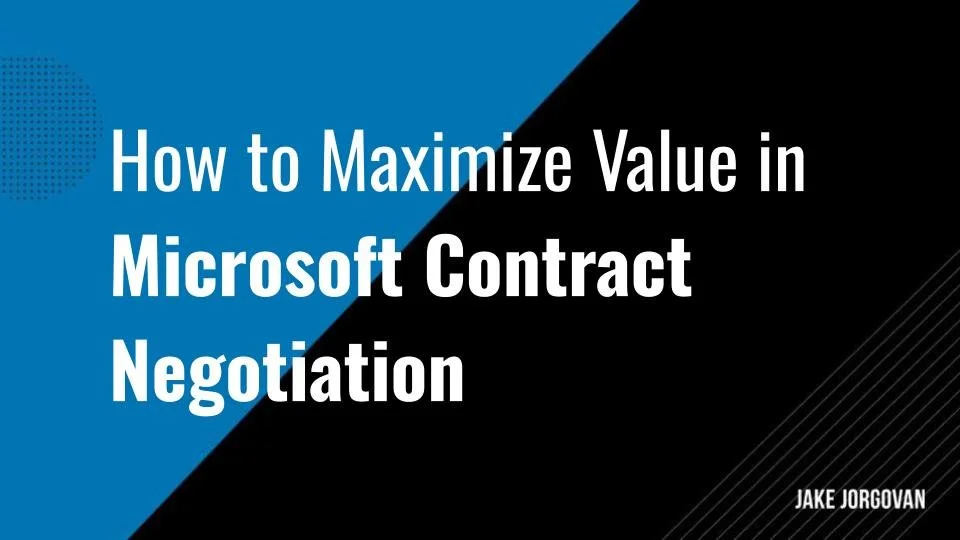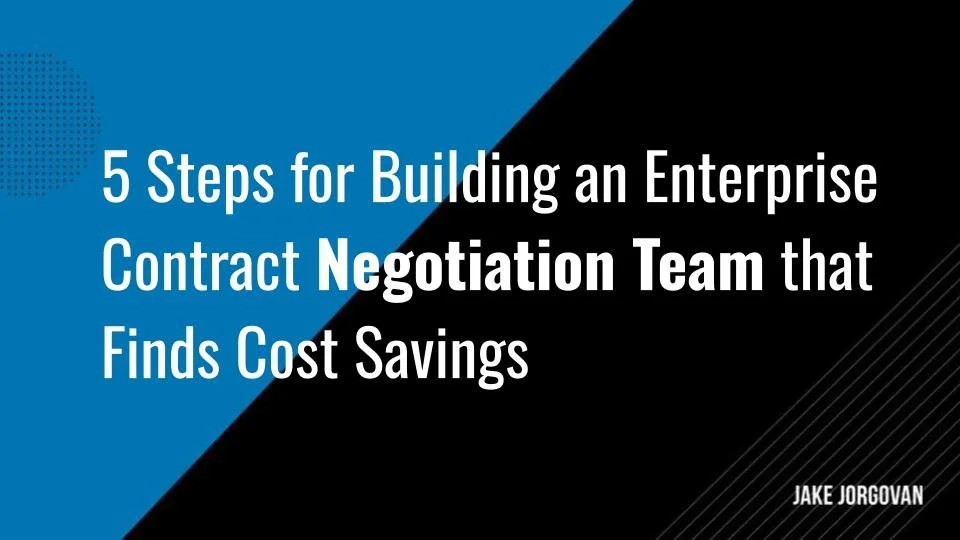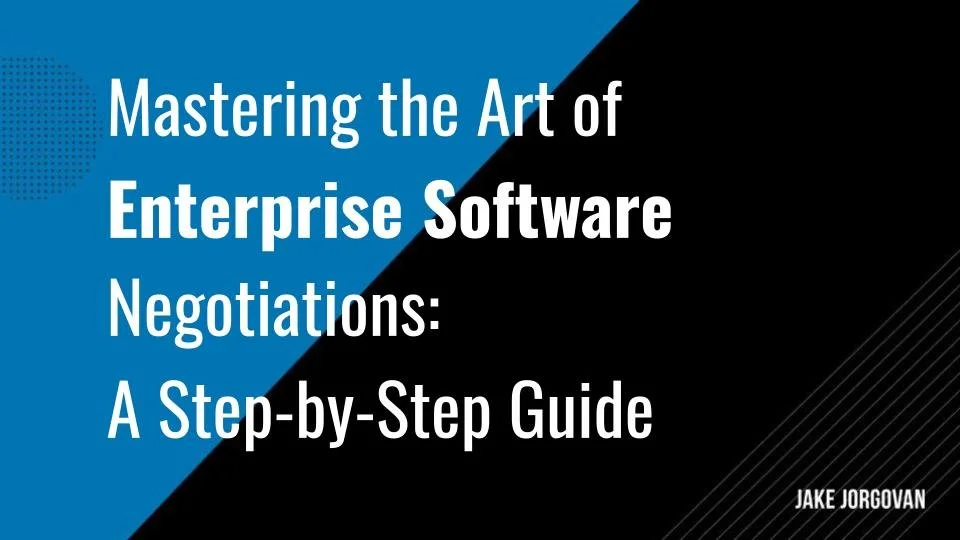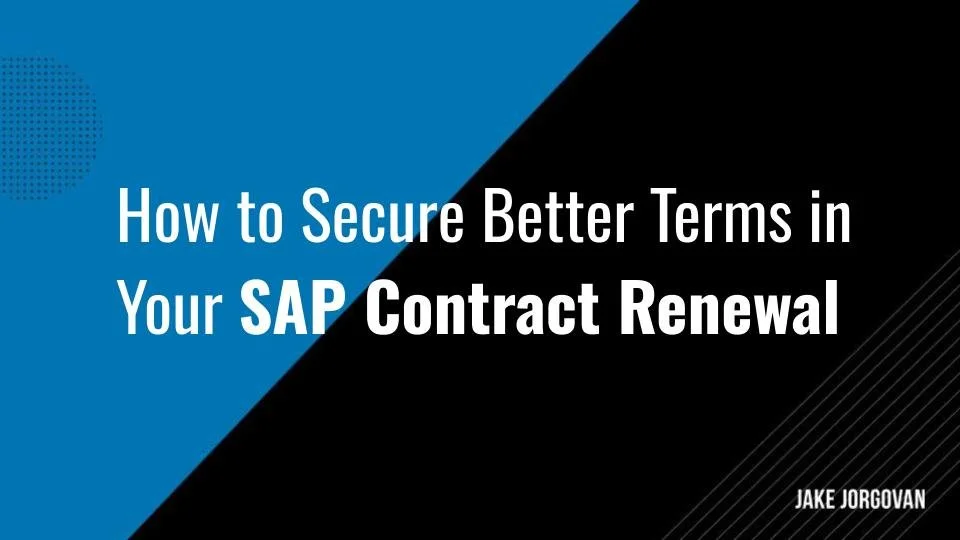Mastering the Art of Enterprise Software Negotiations: A Step-by-Step Guide
The enterprise software market is substantial, with revenues projected to reach approximately $294.30 billion globally by 2024.
Mastering enterprise software negotiations requires precision, strategy, and a deep understanding of your business needs.
Each decision can significantly impact your organization’s technological capabilities and financial health.
This guide provides a clear, step-by-step approach to navigating these complex discussions with vendors like Oracle, Workday, Microsoft, Salesforce, and SAP.
Prepare to improve your negotiation skills and empower your enterprise with the right software solutions.
What are Enterprise Software Agreements?
Enterprise software agreements are contracts that define the terms and conditions under which businesses acquire and use software solutions designed to support large-scale operations. These agreements typically cover areas such as licensing, subscription fees, usage rights, support, and maintenance.
Unlike regular software you might buy for personal use, enterprise software is customized to handle complex organizational needs like data management, customer relations, and resource planning.
“Enterprise software agreement negotiations require three things: up-to-the-minute supplier and negotiation intelligence, diligent preparation, and introspection.” — NPI Financial
These agreements are vital because they establish clear expectations between the software vendor and the business. They outline what the software can be used for, how it will be deployed, and the responsibilities of each party.
For example, a company might agree to pay an annual subscription for cloud-based software while the vendor commits to providing regular updates and technical support. By formalizing these details, enterprise software agreements help ensure the software delivers value while protecting the interests of both parties.
Why Should You Negotiate Enterprise Software Agreements?
Negotiating your enterprise software agreements comes with a ton of benefits, such as:
Cost optimization: Negotiating allows you to secure better pricing, whether it's through discounts, flexible payment plans, or bundling services. This can significantly reduce the overall cost of ownership for expensive enterprise software.
Customizing terms to fit business needs: Each organization has unique requirements. Negotiations help tailor the agreement to align with your operational needs, including usage limits, scalability, and integration with existing systems.
Clarifying support and maintenance expectations: Vendors often offer varying levels of support. By negotiating, you can ensure your business gets adequate technical support, regular updates, and service-level agreements that minimize downtime.
Protecting against unfavorable terms: Some agreements may include clauses that impose penalties or limit your flexibility, such as automatic renewal terms or usage restrictions. Negotiating ensures these terms are fair and manageable.
Maximizing long-term value: Negotiation isn’t just about price; it’s about securing favorable terms that provide value over time. This could include guarantees for future upgrades, training for your team, or early termination options.
6 Key Steps for Effectively Negotiating Enterprise Software Agreements
1) Identify and Prioritize your Software Requirements
What do you need from your potential software solution? Most likely, it’s a list of requirements, such as those shown in the graphic below.
When negotiating enterprise software agreements, this initial step of identifying and prioritizing your software requirements is key. Here’s a streamlined approach to ensure you are thoroughly prepared:
Conduct a technological audit: Begin by assessing your existing technological setup to understand your current capabilities and limitations. This understanding will help you identify the essential features your new software must have.
Align with business objectives: Ensure the software aligns with your strategic business goals. Consider both short-term and long-term impacts. It’s especially important to focus on scalability and relevance to your evolving business needs.
Gather user input: Engage with the departments that will primarily use the software. Collect their insights and preferences to understand their daily challenges and expectations from the new system.
Distinguish must-haves from nice-to-haves: Clearly differentiate between essential features and additional perks. This clarity will help avoid unnecessary expenses on superfluous features during the negotiation phase.
Document your findings: Keep a detailed record of all requirements, user feedback, and strategic alignment. This documentation will be key during negotiations to keep you focused and assertive.
Insider tip: We advise always entering negotiations with a well-defined requirement list vetted against your business objectives. This preparation puts you in a strong position to argue for discounts or additional services. Use this knowledge to your advantage.
2) Research and Select Potential Vendors
Selecting the right vendors is essential in negotiating enterprise software agreements.
To effectively research and choose potential software vendors, start by compiling a list of potential vendors with a robust market presence or those recommended by industry insiders. Use industry reports and rankings to evaluate their market stability and reputation.
Carefully assess each vendor’s offerings against your specific requirements. Ensure the solutions meet current needs and have the capacity for future scalability. One thing companies typically overlook is compatibility with existing systems – but this is essential to avoid additional costs.
Also, be sure to investigate each vendor’s service level agreements to understand the support and services you will receive post-implementation. This can significantly influence your satisfaction and the software’s long-term viability.
“Trust is important, and it’s not enough to just put “most trusted vendor” on a website or brochure. Most companies say they can be trusted, but you need to be certain when your reputation, budget, and job are on the line.” — Eka
Collect case studies and testimonials from existing clients, particularly those in your industry. This step provides insight into how the software performs in real-world environments and the vendor’s responsiveness.
Remember to arrange for software demonstrations or trial periods. These allow you to see the software’s functionality firsthand. Ensure that key team members who will use the software participate in these trials to provide relevant feedback.
Finally, use the detailed information gathered so far to prepare for negotiations. Understanding the vendor landscape thoroughly gives you leverage in discussions. Basically, it helps you advocate effectively for solid terms that meet your business’s needs.
Only two-thirds of companies conduct a proper software evaluation, as shown by the graphic below. This one step can give you a major advantage and help avoid many potential problems further down the line.
3) Develop a Negotiation Strategy
Developing a negotiation strategy for enterprise software agreements requires precision and strategic foresight. It involves several steps, some of which we can see in the graphic below.
Here's a concise guide to formulating your approach:
Assess vendor power: Understand the power dynamics between you and the vendor. If a vendor holds a dominant position in the market, prepare to approach negotiations flexibly. For example, you could leverage collaborations or long-term partnership benefits.
Set clear objectives: Before negotiations begin, clearly define what success looks like for you. Besides, the desired pricing and other crucial elements must be identified. These include support terms, customization options, and scalability.
Plan for concessions: Determine in advance which aspects of the proposed agreement you can be flexible on and where you must stand firm. Being prepared is how you prevent on-the-spot decision-making that could lead to unfavorable compromises.
Utilize a multi-scenario approach: Prepare multiple negotiating scenarios based on how the vendor responds to your initial proposals. This approach keeps you one step ahead and ready to steer the discussions to meet your end goals.
Engage decision-makers: Get stakeholders involved in the negotiation process. These should be people within your company who have the authority to make decisions. Their direct involvement can expedite the agreement and prevent miscommunications.
Prepare documentation: Have all necessary documentation ready and easily accessible. This includes your requirements list, benchmark data, past communication with the vendor, and other relevant information supporting your position.
Insider tip: We stressed the importance of entering negotiations prepared and strategically equipped above as well, but this is really important. In this case, we advise you to master the details of your requirements and anticipate the vendor's moves. This readiness transforms negotiations from mere discussions into strategic dialogues that are more likely to result in favorable outcomes for your business.
4) Review and Understand the Software License Terms
Reviewing and understanding software license terms is a strategic necessity when negotiating an agreement that aligns with your business goals.
To approach this process effectively, start by studying the license type. Software can come with a variety of licensing structures, so it’s important to determine whether the license is perpetual or subscription-based. Each type has different implications for cost, access, and long-term viability, which must align with your business model. There are many types of software licenses out there, as shown in this graphic:
Next, clarify your usage rights under the license. Determine how many users are permitted to access the software and on which systems it can be installed. This step is critical to avoid any legal issues related to overuse or non-compliance with the license terms.
Equally important is examining any restrictions outlined in the agreement. These may include limitations on data usage, privacy considerations, or restrictions on software customization. Understanding these constraints will help you assess whether the software offers the operational flexibility your business needs.
Renewal terms are another essential area to review, particularly for subscription-based licenses. Be clear on the conditions under which prices can increase, and understand your options if you choose not to renew. This foresight allows you to plan for potential cost changes or transitions to alternative solutions.
Additionally, identify any warranty and support clauses included in the agreement. Know what level of support the vendor provides as part of the license fee and whether there are additional costs for enhanced support options. This ensures you’re prepared for any technical issues that may arise post-implementation.
Finally, pay close attention to the termination clauses. Understanding the conditions under which either party can end the agreement will help you develop a solid exit strategy. This is particularly important to avoid unexpected penalties or operational disruptions should you need to part ways with the software vendor. By thoroughly reviewing these key elements, you can negotiate software license terms that not only meet your current business needs but also safeguard your future operations.
5) Negotiate Pricing and Payment Terms
Negotiating pricing and payment terms for enterprise software requires a calculated approach to ensure favorable outcomes. Here’s a detailed roadmap to guide you through this critical negotiation phase:
Prepare your budget: Establish a clear budget before entering negotiations. You need a firm understanding of the maximum you can afford while still maintaining financial health. This preparation anchors your talks and helps you avoid overspending.
Understand the vendor’s pricing model: Familiarize yourself with the vendor's pricing structure. Determine whether the pricing is per user, per module, or a flat fee. This way, you can evaluate the cost implications for your business and identify any potential for volume discounts or bundled savings. The graphic below shows some of the different types of potential pricing models.
Assess the total cost of ownership: Look beyond the sticker price. Consider implementation costs, training fees, maintenance, and any future upgrade expenses. These factors contribute to the total cost of ownership and impact your investment decision.
Negotiate for flexibility: Aim for flexible payment terms that align with your cash flow. If possible, negotiate milestones or performance-based payments corresponding to successful implementation phases or visible benefits to your business.
Seek discounts for early payment: If your cash flow allows, propose an upfront payment for a portion of the cost in exchange for a discount. From our experience, vendors typically welcome the immediate influx of cash and might offer favorable terms in return.
Clarify cancellation terms: Truly understand the financial implications of canceling the service. You need this to protect your business from unexpected costs if the software fails to meet your expectations after implementation.
Insider tip: Treat the negotiation of pricing and payment terms as an opportunity to solidify the partnership with your vendor. Communicate your financial expectations and constraints openly. This dialogue leads to discovering mutually beneficial arrangements that ensure long-term satisfaction and financial viability for your enterprise software investment.
6) Plan for Long-term Relationship Management and Support
Planning for long-term relationship management and support with your software vendor is a cornerstone of success that ensures the ongoing value and effectiveness of your enterprise software.
To build a strong foundation for this partnership, it’s crucial to establish clear communication channels by designating contact points within both your organization and the vendor. These individuals will manage all communications, ensuring messages remain consistent and nothing gets lost in translation. Regular updates and reviews should also be scheduled at agreed-upon intervals. These meetings provide an opportunity to address any issues, align on future needs, and discuss improvements that will optimize the software’s performance.
“Building stronger vendor relationships requires understanding, empathy, and respect. It's essential to maintain transparency during negotiations and to utilize technology to track supplier performance.” — Tradogram
Additionally, defining escalation protocols is vital. Having clear procedures in place for escalating unresolved issues ensures problems are addressed promptly and receive the necessary attention without unnecessary delays. Alongside this, it’s important to negotiate ongoing training and support as part of your agreement. Continuous training keeps your team up to speed on the software’s features and functionalities, which becomes especially valuable as your team grows or changes over time.
Monitoring the vendor’s performance against established service level agreements (SLAs) is another key step. Regularly evaluating performance helps ensure the vendor meets their commitments and provides leverage if renegotiations are needed.
Finally, planning for future scalability is essential. As your business grows and evolves, so will your software needs. Proactively discussing and preparing for scalability from the outset prevents the risk of outgrowing the software solution and ensures it continues to meet your organization’s long-term objectives.
Check out the graphic below for some key elements of vendor management.
Common Mistakes When Negotiating Enterprise Software Agreements
Negotiating software agreements is tough and comes with many potential pitfalls, like those shown in the following graphic and list.
Failing to define business needs clearly
Many companies enter negotiations without a clear understanding of their operational requirements. This can lead to paying for unnecessary features or missing out on critical capabilities.
How to Avoid: Conduct a thorough needs analysis before negotiating and create a prioritized checklist of must-have features.
Overlooking hidden costs
Agreements often include hidden costs like implementation fees, additional user licenses, or data migration expenses. Companies might focus solely on upfront pricing and miss these extras.
How to Avoid: Review the agreement carefully, ask about all potential costs, and ensure the total cost of ownership is transparent.
Ignoring scalability and future needs
Companies may negotiate for their immediate needs without considering future growth. This can result in expensive upgrades or a lack of flexibility as the business expands.
How to Avoid: Include clauses that allow for scalability and address future requirements during the negotiation process.
Not addressing data ownership and exit strategy
Some agreements are vague about who owns the data or what happens when the contract ends. This can lead to costly disputes or loss of critical business data.
How to Avoid: Negotiate clear terms for data ownership, access, and migration in the event of contract termination.
Accepting vendor’s standard terms without question
Vendors often present standard agreements that heavily favor their interests. Companies sometimes accept these without negotiating better terms.
How to Avoid: Engage legal or procurement experts to review the contract and advocate for terms that are balanced and favorable for your business.
Negotiate Enterprise Software Negotiations with Ease
This article taught you the crucial steps to negotiate enterprise software agreements effectively. From identifying your software needs to planning long-term vendor relationships, each step is designed to prepare you for successful negotiations.
As a business owner, it's important for you to approach these negotiations with a clear strategy and thorough preparation.
Remember, your ability to negotiate effectively will significantly impact your business's technological capabilities and overall success.
Use these steps and integrate them into your approach to reap the benefits of well-negotiated software agreements.
Frequently Asked Questions
What are the top negotiation strategies?
The top strategies include thorough preparation, understanding the other party's priorities, leveraging alternatives, focusing on value creation, and maintaining clear communication.
What is negotiation in software?
Negotiation in software involves discussions between a buyer and a vendor to agree on terms such as pricing, licensing, support, and customization so the software serves the buyer’s business needs.
What are the main stages of negotiation?
The main stages are preparation, opening (initial discussions), bargaining (exchange of offers), closing (final agreement), and implementation.
What is the 80/20 rule in negotiations?
The 80/20 rule suggests that 80% of the outcomes in a negotiation come from the final 20% of the discussion.

































